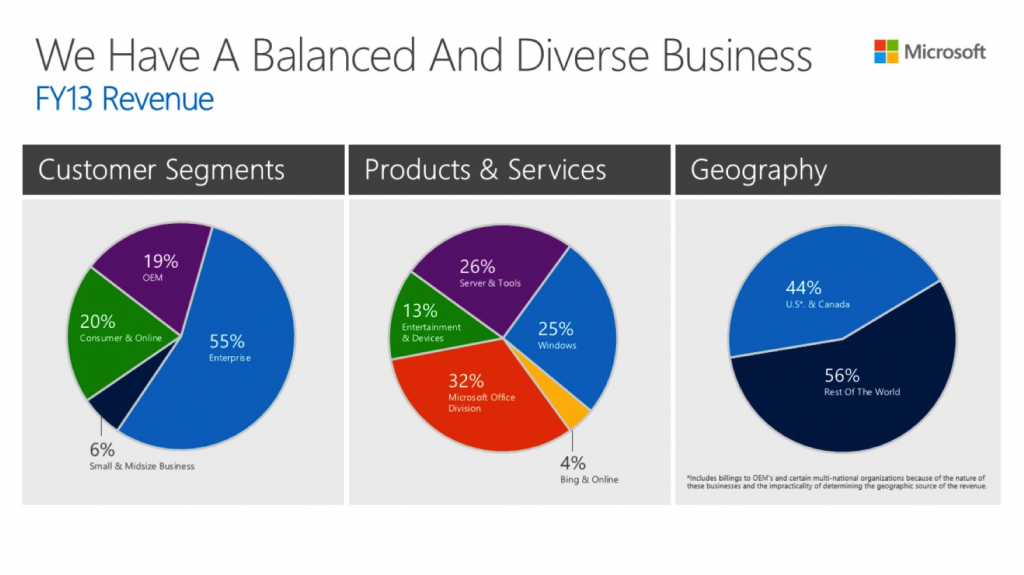With Google’s announcement that it’s offloading the Motorola smartphone business onto Lenovo, we face the intriguing picture of Microsoft and Google apparently moving in opposite directions, with one acquiring a handset business and the other divesting one. What explains this difference between the two companies’ strategies? Is one right, and the other wrong, or does it reflect a fundamental difference in their businesses?
The reality is that, since everyone else now gives them away for free, Microsoft essentially captures 100% of its two core businesses of productivity software and operating systems, and both are likely to shrink. Software may be eating the world from a functionality point of view, but hardware is eating the world from the point of view of revenues. The global market for consumer hardware (smartphones, tablets, PCs and gaming consoles) is about twenty times larger than Microsoft’s revenues from Windows and Office combined. And that explains its organic and inorganic forays into hardware as well as its Xbox business. If you have to choose between hardware and software to build a business in the consumer market, hardware is the way to go. Between Surface, Xbox and Nokia smartphones, Microsoft has around a $10 billion annual revenue stream from hardware already, and Surface and Nokia should grow well in the coming years.
On the other hand, those aren’t the only two parts of the consumer technology market where you can make money. Consumer content and online services are another massive and growing market, and that’s where Google plays through search and advertising. Google’s addressable market is growing rapidly as the online population expands and as more and more of the worldwide advertising market shifts to channels in which Google competes, namely online and mobile. As such, Google doesn’t face the same existential challenge Microsoft does.
The key to Google’s future growth is threefold: the ongoing competitiveness of its online offerings (hence the DeepMind acquisition), the ongoing success of Android as a platform for Google services on mobile devices, and a continued ability to create vast data sets about its users and about the world (hence the Nest acquisition). The acquisition of Motorola was clearly intended to serve its goals around Android, whether by bolstering its patent position, providing leverage over its OEMs or pioneering features and functionality that would become part of the overall Android experience. But if Google believed it could turn Motorola around, it failed hopelessly. At this point there’s really nothing left to be gained by hanging onto Motorola. At its present scale, and with the dominance of Samsung in Android smartphones, there was no way Motorola on its own could ever have achieved the significant growth or margins that would have allowed to contribute to, rather than detract from, Google’s overall financial performance. It had become a millstone around Google’s neck, pure and simple, and had to be cast off. If Google was able to extract some concessions from Samsung in return for the sale of Motorola, so much the better.
As the smartphone and tablet markets grow, Google benefits without having any presence in hardware because the majority of Android devices carry embedded Google services. But for Microsoft to benefit more than marginally, it has to be in the hardware business. Both companies see the same trends, but their positions in the market have led them – rightly, I believe – to radically different conclusions about whether they need to be in the hardware business.
As for Lenovo, they’re now in a very strong position to become the third major company in the consumer hardware business after Samsung and Apple. Last quarter they were number four in smartphones, number four in tablets and number one in PCs. It’s one of the few companies in the hardware business that’s grown profits over the last couple of years and the only one to have grown shipments across all three categories. The biggest challenge for Chinese vendors in the smartphone business has been moving beyond the white label business as HTC did a number of years ago. Both Huawei and ZTE have struggled to establish their own brands in the major carriers’ postpaid channels. But Lenovo will be buying both carrier distribution and a known brand, which should dramatically simplify the process. Moving manufacturing to its facilities in China and taking advantage of domestic scale will also be hugely beneficial. Assuming regulatory approvals come quickly and Lenovo is able to make a quick start, it could quickly leapfrog much more established brands like Sony and LG and take a prominent position in the market.
